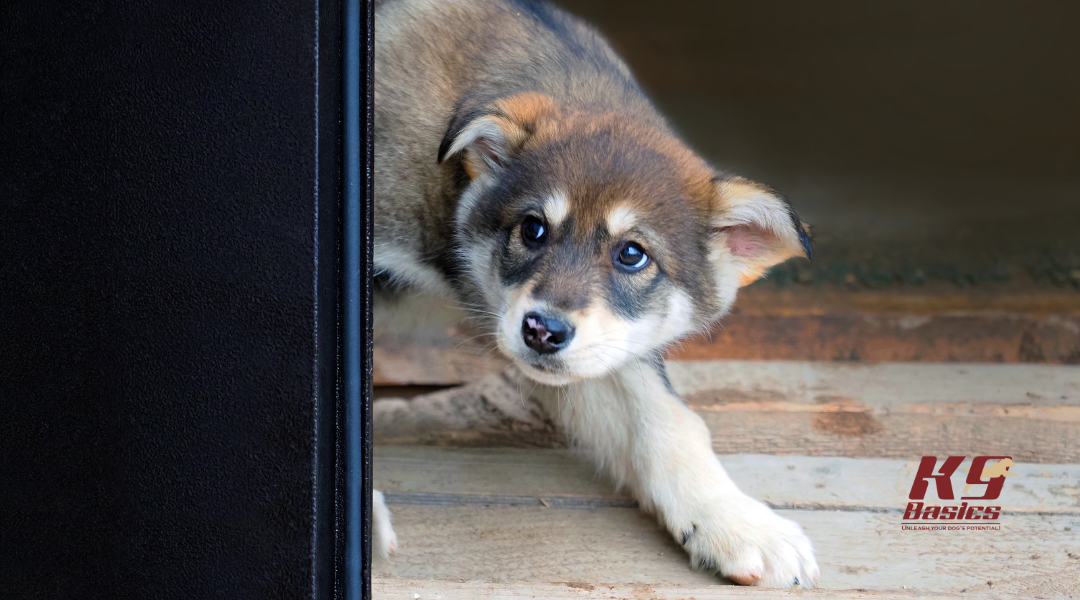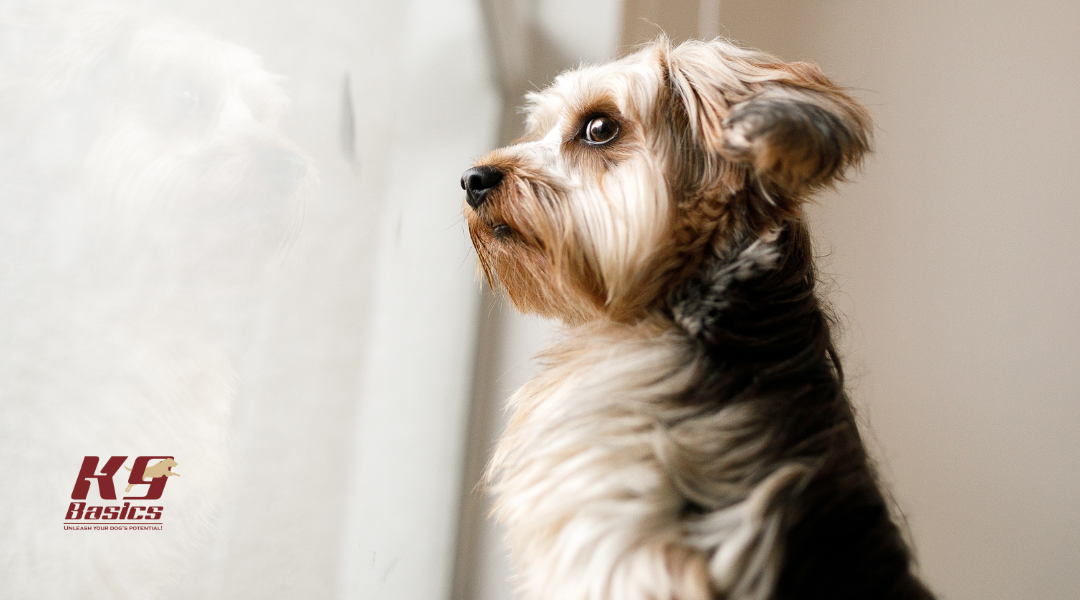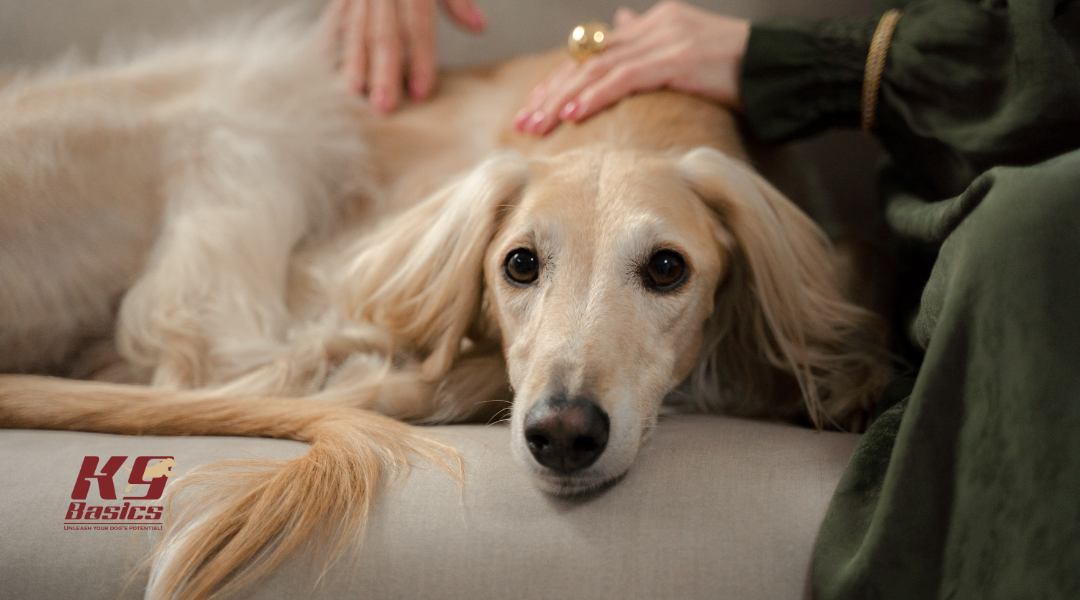Fear can be helpful for any living being, as it’s often a warning of danger. For example, the sound of a speeding car or a growling, hungry animal headed toward you alerts you to get away fast!
But when a dog’s anxiety and fear extend to harmless things, it becomes an anxiety-inducing phobia, not a legitimate warning. Instead, it can be frustrating for them or, in severe cases, a disability. For your dog, almost any sound can trigger noise fear if an association has been established between the item or action and a negative outcome.
We once worked with a German Shepherd named Roger, who would frantically spin in circles at the doorbell sound. He also bit his humans. Roger was a rescue dog, and we suspected that previous owners had created this bizarre reaction to the doorbell. We worked with the dog, and the situation improved after an extensive desensitization process.
Noise Phobia and Anxiety
A dog’s sense of hearing is much stronger than our own. For some dogs, certain sounds can be so intense that they are physically painful. It’s not surprising, then, that many dogs are susceptible to noise-related fears.
A noise phobia is an excessive, irrational fear triggered by a non-threatening sound. The dogs overreact, panic, and try to escape whatever is causing the sound.
An estimated third of all dogs experience noise phobia to some extent. While it can happen at any age, these fears tend to appear most frequently between one and two years of age. Once they have developed a fear of one sound, the fear will likely expand to other sounds if the problem is not addressed.
Certain breeds are more susceptible to noise-related fear, such as Collies, Golden Retrievers, German Shepherds, and other working dogs.

How Does Canine Noise Phobia Manifest Itself?
A dog with noise phobia or anxiety will act as though the noise source is about to attack them. There is a wide variety of ways the dog will express that fear:
- Running to a safe place, hiding, trying to escape.
- Trembling.
- Tail tucked between the legs.
- Panting and drooling.
- Freezing up, not moving.
- Barking, whining, yelping.
- Urinating or defecating in the house.
- Chewing and destroying things.
If panicked enough, a dog may jump through a window to get away. If they have access to the outdoors, they may run away and get lost. Some may even become aggressive.
Causes of Noise Phobia or Anxiety
Natural Fears
Loud, booming noises (e.g., thunder and fireworks) can affect almost any dog. Imagine how it must sound to dogs with their sharper hearing. High-pitched, piercing noises, such as alarms, sirens, and various electronic sounds, can also be bothersome.
Learned Fears
Some sounds become a thing to fear because they’ve become associated with an adverse event. The sound of an umbrella opening may come right before thunder. If the dog has ever experienced a traumatic event, sounds associated with the event become reminders of the trauma and fear triggers. Under the wrong circumstances, any otherwise typical sound can become a dog’s nightmare.
Medical Issues and Senior Dogs
While these fears can begin at any age, senior dogs may develop them due to medical conditions that come with declining health. Their hearing may be more sensitive, and loud noises more painful.

Can a Dog Parent Make Noise Phobia Worse?
Sometimes, the things pet parents do to help their dogs unintentionally create a bigger problem. It’s natural to comfort your distressed dog, but petting and consoling them may only reinforce the fear because it tells the dog that there really is something to fear.
Your dog can read your mood, and they will turn to you as the pack leader for comfort and guidance. Instead of making an overly emotional fuss over them, displaying a calm demeanor is essential. If you fear the same noise, showing it will reinforce the dog’s fears. Do your best to remain calm instead.
How to Help a Dog With Noise Anxiety
It’s best to avoid creating the problem in the first place. Make sure your dog is socialized and exposed to typical noises from a young age. Protect them from traumatic events to the best of your ability. But if one does come along, demonstrate a calm demeanor and remove them from the situation.
Add background noise, such as music or the TV, that can drown out the frightening noise. Put a body wrap on the dog. Mild compression can help calm them. Create a safe space, such as a crate or box with a blanket draped over the top and sides or a small, dark room. Some essential oils can also be soothing.
We’ll walk you through practical stages you can use at home to help your dog gradually build confidence around loud sounds.

Step 1 – Create a Safe, Calm Environment
Before introducing any new sounds, your dog needs a space where they feel completely secure. This could be a crate draped with a blanket, a cozy corner with their favorite bed, or a quiet room where they can retreat when overwhelmed. Adding gentle background noise, such as white noise, soft music, or the hum of a fan, can help soften startling sounds from outside.
For dogs that respond well to physical comfort, a snug body wrap or weighted blanket can also reduce stress. By establishing this safe zone first, you provide your dog with a foundation of calmness that makes it easier for them to approach training without fear.
Step 2 – Start With Low-Level Sound Exposure
Once your pup has established a comfort zone, you can begin introducing the sounds that worry them in a controlled and non-threatening way. Start with recordings of noises like thunder or fireworks at a very low volume, so soft that your dog notices but doesn’t react with fear. The goal is to normalize the sound, not overwhelm them.
Each time the noise plays, pair it with something positive: a favorite treat, a gentle pet, or a short play session. This teaches your dog to associate the sound with good things, gradually changing their emotional response from nervousness to anticipation of reward.
Step 3 – Gradually Increase Volume and Variety
As your dog becomes accustomed to the initial sound exposure, you can gradually increase the volume over time. Progress should always be incremental; going too fast risks undoing the progress you’ve made. When your pup shows they can handle one level without stress, move up slightly and continue pairing the sound with rewards.
Mixing in a variety of noises, from doorbells to traffic sounds, further strengthens your dog’s confidence. The more diverse their sound experiences, the better prepared they’ll be to handle unexpected noises in daily life.
Step 4 – Incorporate Training Commands Into Noise Sessions
Once your dog is responding calmly to controlled sounds, it’s time to layer in familiar commands. Practicing cues like “sit,” “stay,” or “focus” during noise exposure teaches your dog to redirect their energy into listening and following your lead.
These commands give your pup a clear job to do, which helps reduce anxiety in distracting situations. Over time, your dog learns that calmness is a rewarded response, even in noisy environments. This not only builds confidence but also strengthens the trust between you and your dog.
Step 5 – Address Setbacks With Patience
Progress in desensitization is rarely a straight line. Some days your dog may respond beautifully, while other days a sound might trigger anxiety again. Recognizing early stress signals, such as lip-licking, pacing, or ears pinned back, allows you to pause before fear escalates.
When this happens, lower the intensity of the training session and return to a point where your pup feels comfortable. Consistency and patience are key; by moving at your dog’s pace, you build resilience that lasts far beyond the training sessions.
Safety Considerations You Shouldn’t Overlook
Desensitization only works when it’s done gradually. Exposing your dog to overwhelming levels of noise too quickly, known as “flooding,” can actually exacerbate the fear. Training should feel safe and manageable for your dog.
In some cases, especially with severe phobias, professional help may be needed. Our certified trainers can create a customized plan for your pup. Knowing when to seek support ensures your dog’s well-being remains the top priority.

How K9 Basics Helps Sound-Sensitive Dogs
Helping a dog overcome sound sensitivity takes time, patience, and the right techniques. For some families, it’s a journey best supported with professional guidance. At K9 Basics, our trainers understand the stress that noise reactivity can place on both dogs and their owners, and we’re here to provide structured, step-by-step support.
Through our Board & Train programs, dogs receive focused attention in a controlled environment that builds calm responses to challenging situations. Our group classes add an important layer of safe socialization, teaching dogs to remain composed even when life gets noisy. By combining these approaches with positive reinforcement, we help dogs replace fear with confidence.
Most importantly, desensitization isn’t something you have to tackle on your own. Our team is committed to guiding you every step of the way, giving you the tools and coaching to continue progress at home. If your pup struggles with fireworks, thunderstorms, or everyday household noises, we invite you to explore our training services and see how we can help your dog find comfort and calm in any environment.
Help Your Dog Find Confidence in Every Environment with K9 Basics!
Call us at (866) 592-2742 or, if you’re from New Jersey, Pennsylvania, Delaware, or New York, visit us at 131 Kennilworth Road, Marlton, NJ 08053, to learn more about our group training classes.
Also, browse our blog and social media for various topics about dogs and their lives with us!

